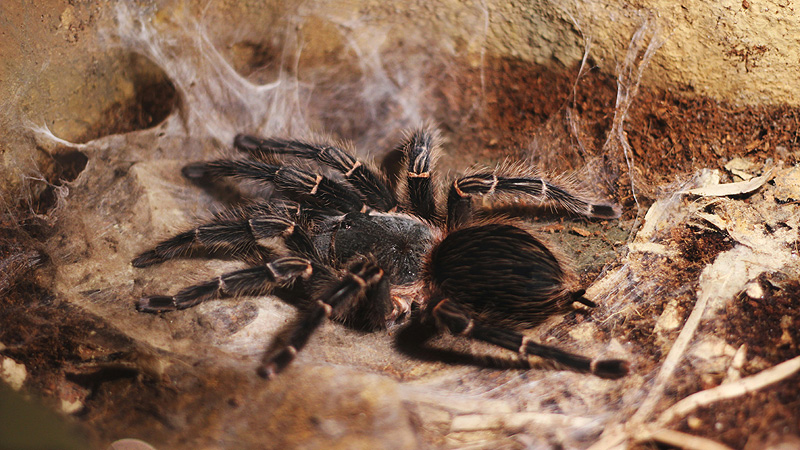What Happens if a Pink Toe Tarantula Bites You?

Photo by Lena Taranenko on Unsplash
Pink toe tarantulas, scientifically known as Avicularia avicularia, are fascinating creatures that capture the imagination of many with their vibrant coloration and unique behaviors.
However, for some, the prospect of being bitten by one of these arachnids can evoke fear and concern. While tarantulas are not typically aggressive towards humans, accidents can happen.
In this article, we delve into the consequences of a pink toe tarantula bite and explore the potential effects on human health.
Anatomy and Behavior of the Pink Toe Tarantula
Before delving into the effects of a pink toe tarantula bite, it's essential to understand the anatomy and behavior of these creatures. Pink-toe tarantulas are arboreal spiders native to the rainforests of South America. They possess a characteristic pinkish coloration on their toes, which distinguishes them from other tarantula species.
Pink toe tarantulas are generally docile and shy in nature. They prefer to spend their time in trees, where they construct silk-lined retreats in crevices or among foliage. Their primary diet consists of insects, although they may occasionally feed on small vertebrates.
When threatened, Pink-toe tarantulas may exhibit defensive behaviors, such as rearing up on their hind legs or flicking urticating hairs from their abdomen. However, they typically reserve biting as a last resort, preferring to flee from potential predators or perceived threats.
Pink Toe Tarantula Bites: Facts and Myths
Contrary to popular belief, Pink Toe Tarantulas are not considered medically significant in terms of their venom potency. Their bites are usually mild and comparable to a bee sting for most individuals. The venom of Pink Toe Tarantulas primarily serves as a means to subdue their prey, rather than cause harm to humans. The fangs of Pink Toe Tarantulas are relatively small in size compared to other more medically significant tarantula species, further reducing the severity of their bites.
In the event that a Pink Toe Tarantula does bite, the most common symptoms experienced by the individual may include localized pain, redness, swelling, and mild irritation at the bite site. Some individuals may also exhibit itchiness or a slight burning sensation. It is essential to note that allergic reactions to tarantula venom are extremely rare, and most people will only experience mild symptoms that subside within a few hours to a day.
First Aid Measures for Pink Toe Tarantula Bites
If you are bitten by a Pink Toe Tarantula, it is crucial to remain calm and follow these first aid measures:
Wash the bite site with mild soap and water to prevent infection.
Apply a cold compress or ice pack wrapped in a cloth to reduce swelling and discomfort.
Elevate the bitten area to minimize swelling, especially if the bite is on a limb.
Refrain from scratching or rubbing the bite site to avoid further irritation.
Monitor the symptoms and seek medical attention if severe reactions occur, such as difficulty breathing, severe swelling, or allergic reactions.
While the majority of Pink Toe Tarantula bites pose minimal health risks, it is always advisable to consult a healthcare professional if you experience unusual or severe symptoms after being bitten. Additionally, individuals with known allergies to arachnid venom should seek medical advice promptly.
Responsible Pet Ownership and Handling Practices
As with all exotic pets, responsible ownership and handling practices are essential when caring for Pink Toe Tarantulas. Understanding the behavior and needs of your tarantula can help prevent accidental bites and ensure a positive interaction between you and your pet. Here are some tips for responsible Pink Toe Tarantula ownership:
Avoid provoking or startling your Pink Toe Tarantula, as stress can lead to defensive behaviors.
Handle your tarantula gently and with care, using proper techniques to prevent accidental bites.
Provide a suitable habitat with ample hiding spots, proper humidity levels, and a secure enclosure to reduce stress.
Monitor your tarantula's health regularly and seek veterinary care if you notice any changes in behavior or appearance.
Educate yourself on the natural history and behaviors of Pink Toe Tarantulas to better understand their needs and tendencies.
By following these guidelines and practicing responsible pet ownership, you can create a safe and enriching environment for your Pink Toe Tarantula while minimizing the risk of potential bites.
Conclusion
In conclusion, Pink Toe Tarantula bites are generally mild and pose minimal health risks to humans. While this species of tarantula is known to have venom, its bite is typically not considered dangerous or medically significant. In most cases, the symptoms of a Pink Toe Tarantula bite are limited to localized pain, redness, and swelling at the site of the bite. These symptoms usually resolve on their own without the need for medical intervention.
It is important to note that individual reactions to spider bites can vary, and some people may experience more severe symptoms or have an allergic reaction. If you or someone else experiences symptoms beyond the expected mild discomfort, such as severe pain, extensive swelling, difficulty breathing, or other systemic symptoms, it is recommended to seek medical attention.
You May Also Like
 Other Pets50 Popular Names for Tarantulas (with Meaing)
Other Pets50 Popular Names for Tarantulas (with Meaing) Other PetsAre Cobalt Blue Tarantulas Suitable for Beginners?
Other PetsAre Cobalt Blue Tarantulas Suitable for Beginners? Other PetsThe Price of Cobalt Blue Tarantula in the US ($50 to $200)
Other PetsThe Price of Cobalt Blue Tarantula in the US ($50 to $200) Other Pets6 Best Tarantula Species for Beginners
Other Pets6 Best Tarantula Species for Beginners Other PetsWhat Happens if a Cobalt Blue Tarantula Bites You?
Other PetsWhat Happens if a Cobalt Blue Tarantula Bites You? Other Pets10 FAQs About Cobalt Blue Tarantulas
Other Pets10 FAQs About Cobalt Blue Tarantulas